Traditional Filipino games preserve cultural heritage. These games, such as Sungka, Patintero, and Sipa, foster community bonding and enhance social interaction among people of all ages, bridging the gap between generations. Furthermore, these traditional Filipino games are not just a form of entertainment, but also a way of preserving the legacy of kampilan, the traditional Filipino sword. Through these games, the values and skills necessary for the use of kampilan are passed down from one generation to the next, ensuring that this important aspect of Filipino heritage continues to thrive. Additionally, the popularity of these games also serves as a means of promoting cultural pride and identity among the Filipino people.
Sungka promotes strategic thinking, while Patintero encourages teamwork, making these games both entertaining and enriching.
Regional variations of these games reflect local traditions, adding to their cultural significance.
However, urbanization and digital entertainment pose a threat to their relevance.
Community advocacy and events are crucial in keeping these games alive, ensuring that a vital part of Filipino cultural identity remains vibrant and cherished.
Cultural Importance of Traditional Games
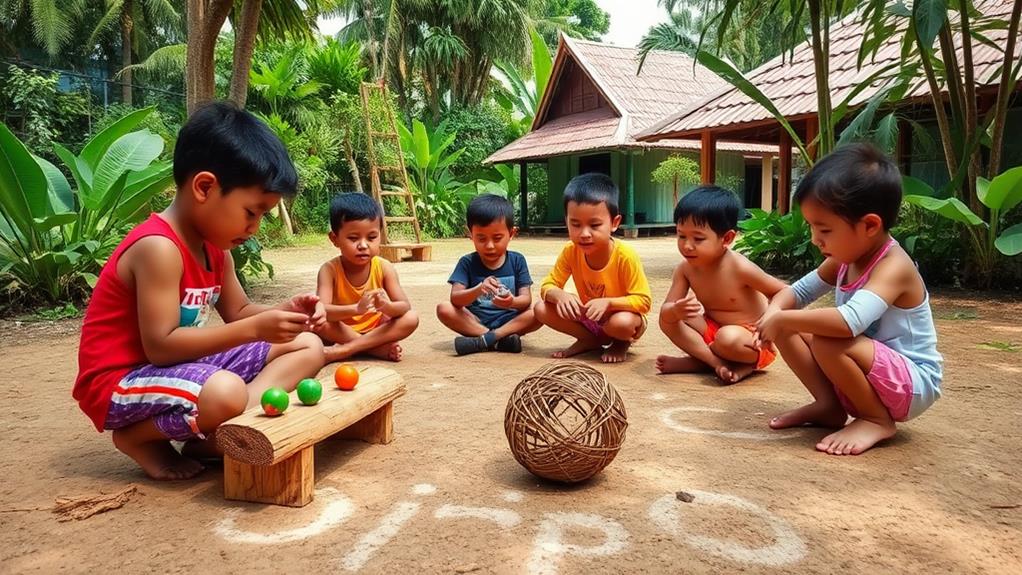
Traditional Filipino games are a vital part of the country's cultural heritage. These games, such as Sungka, Patintero, and Sipa, embody values that connect generations and communities, fostering community bonding and social interaction. By engaging in these games, players reinforce connections with one another and instill pride in their heritage.
These games promote teamwork and resourcefulness. They often utilize locally sourced materials, reflecting the creativity inherent in Filipino culture and emphasizing the importance of indigenous practices passed down through generations.
Events like Palaro ng Lahi ensure these games remain celebrated and relevant in today's society.
Participating in traditional games contributes to physical fitness and cognitive development for children. The blend of physical activity and strategic thinking in games like Patintero and Sipa sharpens children's skills, making these games an essential aspect of holistic childhood development.
By embracing these games, Filipinos are preserving a rich tapestry of storytelling and folklore, ensuring the vibrancy of Filipino culture continues to thrive.
Overview of Popular Games
Traditional Filipino games are more than just entertainment; they foster community bonding and showcase cultural identity.
Sungka, a popular traditional game, requires strategic thinking as players maneuver shells or seeds across a wooden board to outsmart their opponents. This game embodies critical thinking and problem-solving skills.
Patintero, another well-known game, emphasizes teamwork as players navigate designated lines while avoiding tags. This game fosters camaraderie and communication among participants.
Sipa, a fast-paced game, showcases agility and coordination as players kick a rattan ball to keep it airborne. This game demonstrates quick reflexes and spatial awareness.
What's remarkable about these traditional games is that they utilize simple, locally available materials, highlighting the ingenuity and resourcefulness inherent in Filipino culture.
They reinforce cultural identity and create shared experiences that bond communities together. By participating in these games, players are preserving an important aspect of heritage, ensuring that the spirit of Filipino culture thrives across generations.
Mechanics of Key Games
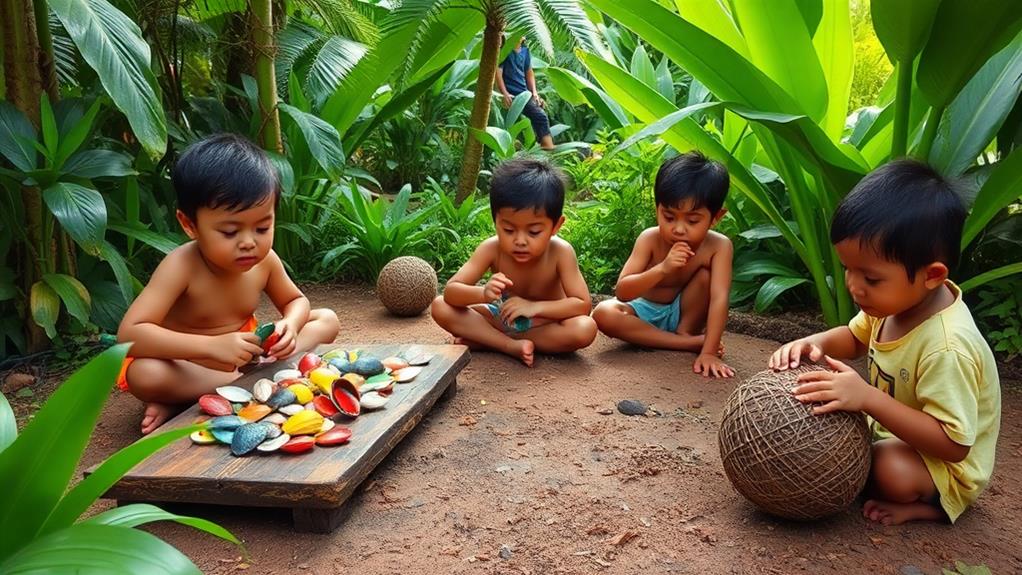
Traditional Filipino games embody strategic depth and social dynamics.
In Sungka, a two-player game, strategy is key as players manipulate 49 shells across a board with 14 holes. To win, players must select holes to maximize their captures while anticipating their opponent's moves.
Teamwork and agility are essential in Patintero.
In this game, teams plot their approach to cross designated lines without being tagged by defenders. Success depends on devising clever maneuvers and coordinating with teammates to outsmart the opposing side.
Sipa showcases agility and coordination.
Players keep a washer or rattan ball airborne using their feet, displaying skill and competing with friends. Each kick requires precision, and maintaining control fosters a sense of friendly rivalry.
The mechanics of these games reflect cultural values, emphasizing strategy, teamwork, and social interaction.
Each game contributes to the rich tapestry of Filipino culture, embodying the essence of traditional Filipino games.
Physical Activity and Social Interaction
Filipino Games: Boosting Physical Fitness and Social Interaction
Engaging in traditional Filipino games like Sungka, Patintero, and Sipa offers a unique combination of physical activity and social benefits. By participating in these games, individuals can enhance their physical fitness levels while fostering meaningful connections within their community.
Benefits of Filipino Games
| Game | Benefits |
|---|---|
| Sungka | Promotes social engagement and strategy |
| Patintero | Enhances communication and teamwork |
| Sipa | Improves coordination and community bonding |
Patintero: A Game of Strategy and Communication
In Patintero, players must strategize and communicate effectively to succeed. This not only keeps players physically active but also promotes social interaction among teammates. Effective communication is key to winning the game, as players need to work together to outmaneuver their opponents.
Sungka: Fostering Social Engagement
Sungka encourages social gatherings, allowing players to share experiences and create lasting relationships. The game's social nature strengthens community bonds, as players often gather to play and socialize.
Sipa: Building Community Bonds
Sipa, often played in public spaces, cultivates community bonding by bringing people together to enjoy the challenge and excitement of the game. Playing Sipa in public spaces promotes a sense of community, as players and spectators alike come together to enjoy the game.
The Communal Nature of Filipino Games
The communal nature of these Filipino games reinforces cultural values, creating a sense of belonging that transcends mere competition. By engaging in these activities, individuals participate in a vital tradition that strengthens community ties and celebrates their shared heritage.
Unique Regional Variations
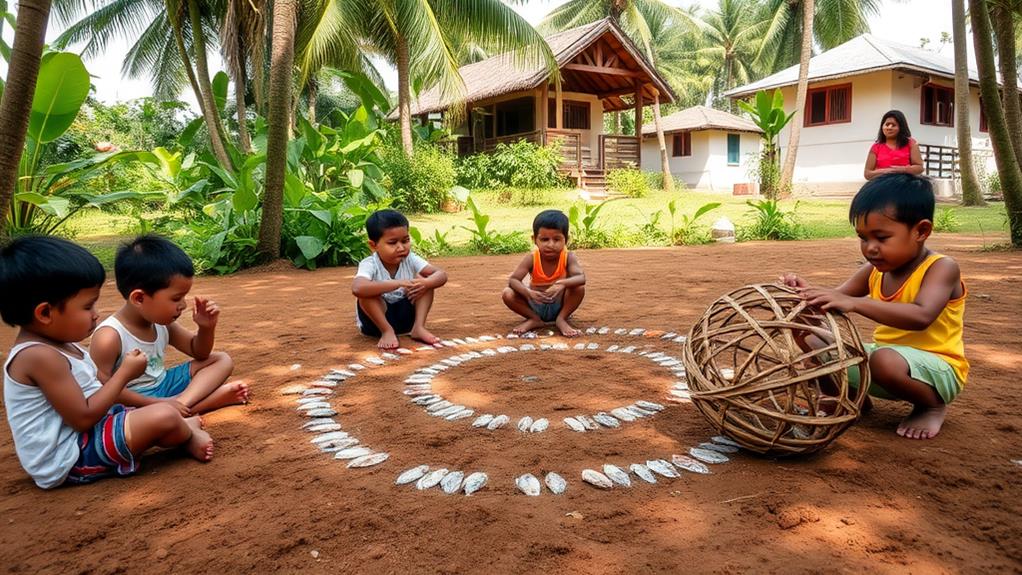
Regional Variations Enrich Traditional Filipino Games
Traditional Filipino games are more than just physical activities and social interactions; they also showcase the country's rich cultural diversity.
Each game adapts to its local context, creating unique regional variations that reflect community dynamics.
Take Sungka, a popular counting game, for example. In certain regions, boards are crafted from different materials like seashells or stones, altering the gameplay experience.
Patintero, a classic tag game, varies widely across regions. Local rules dictate the number of players, specific strategies for crossing lines, and even distinct tagging styles.
In Sipa, a game similar to badminton, adaptations involve different types of balls or shuttlecocks, such as rattan or rubber, influencing play style and skill development.
Games like Agawan Base emphasize local preferences through regional rules that change base locations and tagging methods.
Even game names can differ, as Tumbang Preso might be called presohan in some areas, showcasing linguistic diversity.
These regional variations not only enrich the cultural tapestry but also strengthen community bonds through shared yet unique experiences.
Modern Challenges and Advocacy
Traditional Filipino games face significant modern challenges that threaten their survival.
These challenges manifest in several ways:
- Urbanization and lifestyle changes have led to decreased outdoor play, as children spend more time indoors and in front of screens.
- Digital entertainment competes for children's attention, distracting them from traditional games and outdoor activities.
- Limited awareness of cultural heritage among younger generations means they may not understand the significance of these games.
- Inadequate community spaces make it difficult for traditional games to thrive.
Organizations like the Magna Kultura Foundation are working to combat these issues.
They advocate for the integration of traditional games into educational programs and community events, ensuring that kids understand their cultural significance.
For example, the Palaro ng Lahi initiative, launched in 1984, emphasizes the importance of these games in physical education, helping to revitalize interest in outdoor play.
Social media campaigns and local festivals also play a crucial role.
They foster a sense of pride in Filipino culture, encouraging more families to participate in traditional activities.
Skill Development Through Play
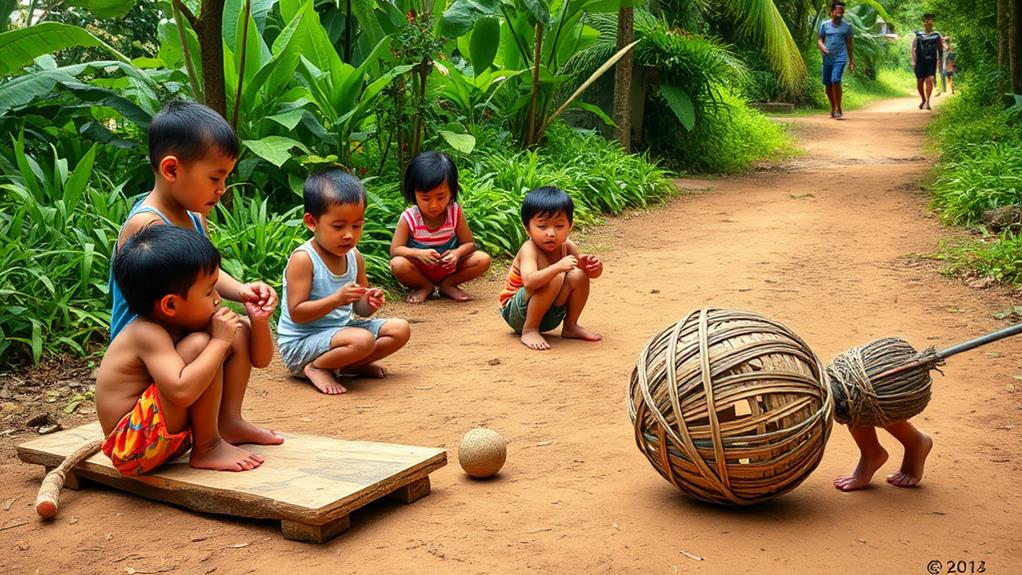
Traditional Filipino games are valuable tools for skill development. Playtime isn't just for entertainment; it's an opportunity to hone critical thinking skills, foster collaboration, and improve physical fitness.
Critical thinking skills are developed through games like Sungka. When playing Sungka, you strategize to capture the most seeds, honing your analytical abilities essential for problem-solving in various aspects of life.
Teamwork and collaboration are fostered through games like Patintero. In Patintero, you coordinate with teammates to navigate obstacles and avoid being tagged, strengthening your collaboration skills and teaching you the importance of communication and cooperation.
Physical fitness and motor skills are improved through games like Sipa. Mastering Sipa, where you keep a rattan ball airborne, challenges your agility and coordination, improving your overall physical fitness.
Similarly, playing Piko cultivates precision and spatial awareness, as you learn to toss your cue ball accurately onto designated squares.
Emotional intelligence is developed through social interactions and shared experiences. Through these traditional games, you build relationships, developing emotional intelligence and shaping well-rounded individuals.
How Does Traditional Filipino Games Compare to Mobile Legends: Bang Bang in terms of Keeping Culture Alive?
Traditional Filipino games hold a significant place in Filipino culture, fostering values of teamwork, resilience, and sportsmanship. On the other hand, the impact of mobile legends on filipino gamers has introduced a new form of entertainment, possibly impacting the popularity of traditional games. However, both play a role in preserving the country’s rich cultural heritage.
How Are Traditional Filipino Games Like Sungka and Patintero Connected to Philippine Mats and Weaving Traditions?
Traditional Filipino games such as Sungka and Patintero are deeply connected to Philippine mats and weaving traditions. These games are often played on intricately woven mats, showcasing the skill and artistry of Filipino weavers. The intricate patterns of philippine mats are a reflection of the rich cultural heritage of the Philippines.
Games for All Ages
Traditional Filipino games like Sungka, Patintero, and Sipa bring people together across generations, creating a vibrant tapestry of community interaction. These games aren't limited to children; they foster intergenerational bonding, allowing everyone to participate and enjoy.
Inclusivity is a key factor in their widespread appeal. These games welcome participants of varying ages, ensuring everyone can join in the fun. For example, Sungka can be played by both children and adults, promoting a sense of community and togetherness.
Games like Sungka enhance critical thinking and mathematical skills, making them intellectually engaging for both kids and adults. This is because Sungka requires players to strategize and think critically to win.
Patintero promotes cooperation, making it a hit during community gatherings, where teamwork becomes essential. Players must work together to block their opponents, developing essential communication and collaboration skills.
Sipa encourages fitness and agility, appealing to families who enjoy active play. This traditional game involves hitting a ball with the feet, promoting physical activity and coordination.
These games serve as more than just entertainment; they preserve cultural heritage by imparting values and customs. As you gather with friends and family to play, you're not only having fun but also keeping your community's rich traditions alive.
Traditional Filipino games like these create lasting connections, bridging the gap between young and old while celebrating a shared cultural legacy.
Efforts in Cultural Preservation
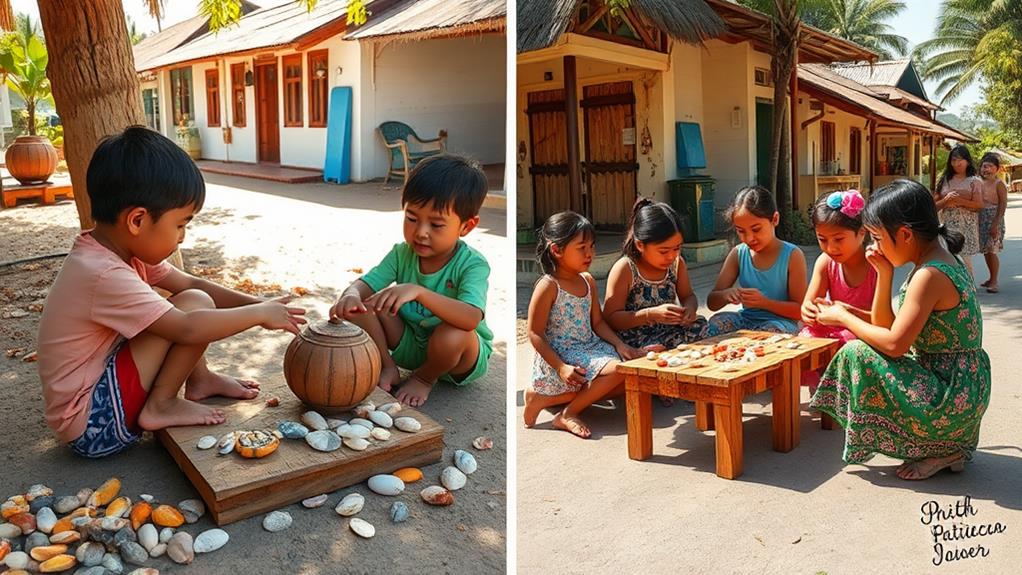
Efforts to preserve traditional Filipino games have gained significant momentum in recent years. Organizations like the Magna Kultura Foundation are leading this movement by promoting these games through community events and educational initiatives.
For instance, they focus on preserving games such as Sungka, Patintero, and Sipa, ensuring they remain vibrant and relevant.
The Palaro ng Lahi initiative integrates traditional games into physical education programs. Launched in 1984, this initiative fosters heritage awareness among youth.
Local governments collaborate with cultural organizations to hold festivals and tournaments, celebrating these games and encouraging intergenerational participation.
Schools are incorporating traditional Filipino games into their curricula. This approach reinforces the importance of cultural heritage while promoting physical activity.
Additionally, digital platforms and social media campaigns enhance accessibility, modernizing traditional gameplay and reaching a wider audience.
By participating in these activities, individuals contribute to the ongoing narrative of Filipino culture, ensuring its legacy thrives for future generations.
Questions and Answers
What Is the Cultural Significance of Sungka?
Sungka's cultural significance stems from its unique blend of history and community engagement. The game has been a part of Filipino traditions for centuries, bringing people together and fostering social connections.
As a game that encourages strategic thinking, sungka helps develop critical thinking skills and problem-solving abilities.
Sungka reflects cultural heritage by showcasing historical origins and modern adaptations. The game's evolution over time demonstrates the dynamic nature of Filipino culture, adapting to changing times while preserving its roots.
Through sungka, players learn about their cultural history and its significance in modern times.
Sungka serves as a tool for skill development and educational benefits. The game teaches various math concepts, such as counting, addition, and subtraction, in an engaging and enjoyable way.
Playing sungka helps children develop their math skills, making it an effective educational tool.
Sungka fosters social interactions and community building. The game is often played in groups, promoting social bonding and friendly competition.
Through sungka, players develop essential social skills, such as communication, teamwork, and sportsmanship.
What Is the Traditional Game Sungka in the Philippines?
What Is Sungka?
Sungka is a traditional Filipino game played on a wooden board with two rows of holes filled with pebbles or shells.
Objective and Strategies
The objective of Sungka is to outsmart your opponent by developing strategies to collect more pebbles or shells than them.
To achieve this, players must follow specific rules and think analytically to win.
History and Popularity
Sungka has a rich history and variations that have made it popular across different ages.
It fosters community spirit through tournaments, connecting people to a vibrant cultural legacy shared by many players.
Cognitive Benefits
Engaging with Sungka not only sharpens analytical skills but also promotes strategic thinking and problem-solving abilities.
What Is the Traditional Filipino Game Patintero?
Patintero is a traditional Filipino game that emphasizes community engagement and strategy.
In this game, players navigate lines while avoiding defenders, utilizing clever strategies to outsmart their opponents. The game requires players to think critically and make quick decisions to win.
Patintero has a rich history, with various adaptations and rules that enhance its popularity at local tournaments.
The game is often played in local communities, with each region having its own unique rules and variations. This adaptability has contributed to the game's enduring popularity.
The equipment required to play Patintero is simple, often just chalk or string.
The minimal equipment needed makes it accessible to people of all ages and backgrounds, allowing anyone to participate and enjoy the game.
Playing Patintero has several benefits, including improved physical fitness and teamwork.
The game requires players to be physically active, promoting overall fitness and health.
Additionally, Patintero encourages teamwork and communication among players, fostering social bonds and camaraderie.
What Are the Traditional Filipino Games or Indigenous Games in the Philippines Commonly?
Traditional Filipino games offer a diverse range of activities that promote physical and mental skills.
One popular game is Luksong Baka, where players take turns jumping over each other, promoting agility and coordination.
Another game, Tumbang Preso, requires players to knock down a can with a slipper, developing hand-eye coordination and throwing skills.
Games that challenge agility and strategy include Piko and Agawan Base.
Piko Game requires players to hop on one foot while moving around a series of squares drawn on the ground, testing their balance and agility.
Agawan Base, on the other hand, is a tag game that requires strategy and quick thinking to capture the opposing team's base.
Games that focus on flexibility and coordination include Chinese Garter and Luksong Tinik.
Chinese Garter involves players jumping over a garter while performing different movements, such as skipping and hopping.
Luksong Tinik, a variation of tag, requires players to jump over a "tinik" (a small obstacle) while chasing each other.
Other traditional Filipino games include Sipa Ball, Bati Cobra, and Pabitin Festival.
Sipa Ball is a game that showcases coordination and throwing skills, where players hit a ball with their feet or knees.
Bati Cobra adds excitement with its fast-paced gameplay, where players try to hit a ball with a long stick.
Pabitin Festival is a festive celebration that features various games and activities, including Sipa Rung, a game that requires agility and coordination to hit a ball with a long stick.